Wavelength-Flexible Thulium-Doped Fiber Laser Based on Digital Micromirror Array
Abstract
:1. Introduction
2. Operating Principle and System Design
2.1. Operating Principle of TDFL
2.2. Diffraction Performance of DMD
2.3. Optimization of Bulk Optics
3. Characteristics of Tunable TDFL
4. Conclusions
Author Contributions
Funding
Conflicts of Interest
References
- McComb, T.S.; Sims, R.A.; Willis, C.C.C.; Kadwani, P.; Sudesh, V.; Shah, L.; Richardson, M. High-power widely tunable thulium fiber lasers. Appl. Opt. 2010, 49, 6236–6242. [Google Scholar] [CrossRef] [PubMed] [Green Version]
- Zhang, M.; Kelleher, E.J.R.; Torrisi, F.; Sun, Z.; Hasan, T.; Popa, D.; Wang, F.; Ferrari, A.C.; Popov, S.V.; Taylor, J.R. Tm-doped fiber laser mode-locked by graphene-polymer composite. Opt. Express 2012, 20, 25077–25084. [Google Scholar] [CrossRef] [PubMed] [Green Version]
- Gumenyuk, R.; Vartiainen, I.; Tuovinen, H.; Okhotnikov, O.G. Dissipative dispersion-managed soliton 2 μm thulium/holmium fiber laser. Opt. Lett. 2011, 36, 609–611. [Google Scholar] [CrossRef] [PubMed]
- Hemming, A.; Bennetts, S.; Simakov, N.; Davidson, A.; Haub, J.; Carter, A. High power operation of cladding pumped holmium-doped silica fibre lasers. Opt. Express 2013, 21, 4560–4566. [Google Scholar] [CrossRef]
- Wang, T.; Ma, W.; Jia, Q.; Su, Q.; Liu, P.; Zhang, P. Passively mode-locked fiber lasers based on nonlinearity at 2-µm band. IEEE J. Sel. Top. Quantum Electron. 2018, 24, 1102011. [Google Scholar] [CrossRef]
- Belal, M.; Alam, S.U.; Sahu, J.K.; Richardson, D.J.; Newson, T.P. Demonstration of a 2 μm-OTDR. In Proceedings of the Optical Communication (ECOC 2013), 39th European Conference and Exhibition, London, UK, 22–26 September 2013. [Google Scholar]
- Li, Z.; Heidt, A.M.; Daniel, J.M.O.; Jung, Y.; Alam, S.U.; Richardson, D.J. Thulium-doped fiber amplifier for optical communications at 2 μm. Opt. Express 2013, 21, 9289–9297. [Google Scholar] [CrossRef] [Green Version]
- Liu, Z.; Chen, Y.; Wooler, J.P.; Kelly, B.; Phelan, R.; O’Carroll, J.; Wheeler, N.V.; Heidt, A.M.; Poletti, F.; Petrovich, M.N.; et al. Up to 64QAM (30 Gbit/s) directly-modulated and directly-detected OFDM at 2 μm wavelength. In Proceedings of the 2014 the European Conference on Optical Communication (ECOC), Cannes, France, 21–25 September 2014; pp. 1–3. [Google Scholar]
- Liu, S.; Yan, F.; Peng, W.; Feng, T.; Dong, Z.; Chang, G. Tunable Dual-Wavelength Thulium-Doped Fiber Laser by Employing a HB-FBG. IEEE Photon. Technol. Lett. 2014, 26, 1809–1812. [Google Scholar] [CrossRef]
- He, Z.; Zhang, P.; Wu, D.; Wu, X.; He, S.; Wei, J.; Gong, X.; Li, X.; Wang, T.; Han, K.; et al. 1.7 μm Tm-doped continue-wave and pulse fibre laser using a modulated pump based on variable pulse generated mechanisms. Opt. Laser Technol. 2020, 131, 106450. [Google Scholar] [CrossRef]
- Zhang, L.; Yan, F.; Feng, T.; Han, W.; Bai, Y.; Bai, Z.; Cheng, D.; Zhou, H.; Suo, Y. Wavelength-tunable thulium-doped fiber laser with sampled fiber Bragg gratings. Opt. Laser Technol. 2019, 120, 105707. [Google Scholar] [CrossRef]
- Liu, S.; Yan, F.; Feng, T.; Wu, B.; Dong, Z.; Chang, G.-K. Switchable and spacing-tunable dual-wavelength thulium-doped silica fiber laser based on a nonlinear amplifier loop mirror. Appl. Opt. 2014, 53, 5522–5526. [Google Scholar] [CrossRef]
- Sabra, M.; Leconte, B.; Darwich, D.; Dauliat, R.; Tiess, T.; Jamier, R.; Humbert, G.; Jaeger, M.; Schuster, K.; Roy, P. Widely Tunable Dual-Wavelength Fiber Laser in the 2 μm Wavelength Range. J. Light. Technol. 2019, 37, 2307–2310. [Google Scholar] [CrossRef]
- Durán-Sánchez, M.; Álvarez-Tamayo, R.I.; Posada-Ramírez, B.; Ibarra-Escamilla, B.; Kuzin, E.A.; Cruz, J.L.; Andrés, M.V. Tunable Dual-Wavelength Thulium-Doped Fiber Laser Based on FBGs and a Hi-Bi FOLM. IEEE Photon. Technol. Lett. 2017, 29, 1820–1823. [Google Scholar] [CrossRef] [Green Version]
- Wang, M.; Huang, Y.; Yu, L.; Song, Z.; Liang, D.; Ruan, S. Multi-wavelength thulium-doped fiber laser using a micro fiber-optic Fabry-Perot interferometer. IEEE Photon. J. 2018, 8, 1–8. [Google Scholar]
- Wang, Y.P.; Ju, Y.L.; Wu, C.T.; Liu, W.; Yang, C. Wavelength-tunable thulium-doped fiber laser by employing a self-made Fabry–Perot filter. Laser Phys. 2017, 27, 65111. [Google Scholar] [CrossRef]
- Peng, W.; Yan, F.; Li, Q.; Liu, S.; Feng, T.; Tan, S. A 1.97 μm multi-wavelength thulium-doped silica fiber laser based on a nonlinear amplifier loop mirror. Laser Phys. Lett. 2013, 10, 115102. [Google Scholar] [CrossRef]
- Chen, E.; Liu, S.; Lu, P.; Zhang, J.; Lian, Z.G. Tunable 2 μm fiber laser utilizing a modified sagnac filter incorporating cascaded polarization maintaining fibers. IEEE Photon. J. 2020, 12, 1–7. [Google Scholar] [CrossRef]
- Liu, S.; Yan, F.; Ting, F.; Zhang, L.; Bai, Z.; Han, W.; Zhou, H. Multi-wavelength Thulium-doped fiber laser using a fiber-based Lyot filter. IEEE Photon. Technol. Lett. 2016, 28, 864–867. [Google Scholar] [CrossRef]
- Sun, B.; Luo, J.; Yan, Z.; Liu, K.; Ji, J.; Zhang, Y.; Wang, Q.J.; Yu, X. 1867–2010 nm tunable femtosecond thulium-doped all-fiber laser. Opt. Express 2017, 25, 8997. [Google Scholar] [CrossRef]
- Ma, W.; Wang, T.; Zhang, Y.; Liu, P.; Su, Y.; Jia, Q.; Bi, M.; Zhang, P.; Jiang, H. Widely tunable 2 μm continuous-wave and mode-locked fiber laser. Appl. Opt. 2017, 56, 3342–3346. [Google Scholar] [CrossRef]
- Zhang, P.Z.P.; Ma, W.; Wang, T.W.T.; Jia, Q.J.Q.; Wan, C.W.C. Stable multi-wavelength thulium-doped fiber laser based on all-fiber Mach–Zehnder interferometer. Chin. Opt. Lett. 2014, 12, 111403–111406. [Google Scholar] [CrossRef]
- Ahmad, H.; Sharbirin, A.S.; Muhamad, A.; Samion, M.Z.; Ismail, M.F.I.M.F. 2µm mode-locked thulium-doped fiber laser using Mach-Zehnder interferometer tuning capability. Laser Phys. 2017, 27, 65104. [Google Scholar] [CrossRef]
- Wei, H.; Zhu, L.; Mingli, D.; Fei, L. A 1.8-µm multiwavelength thulium-doped fiber laser based on a hybrid interference filter. Int. J. Optomechatron. 2016, 10, 154–161. [Google Scholar] [CrossRef] [Green Version]
- Xiao, F.; Alameh, K.; Lee, T. Opto-VLSI-based tunable single-mode fiber laser. Opt. Express 2009, 17, 18676–18680. [Google Scholar] [CrossRef] [PubMed] [Green Version]
- Shin, W.; Lee, Y.; Yu, B.-A.; Noh, Y.-C.; Ahn, T.-J. Wavelength-tunable thulium-doped single mode fiber laser based on the digitally programmable micro-mirror array. Opt. Fiber Technol. 2013, 19, 304–308. [Google Scholar] [CrossRef]
- Ai, Q.; Chen, X.; Tian, M.; Yan, B.B.; Zhang, Y.; Song, F.J.; Chen, G.X.; Sang, X.Z.; Wang, Y.Q.; Xiao, F.; et al. Demonstration of multi-wavelength tunable fiber lasers based on a digital micromirror device processor. Appl. Opt. 2015, 54, 603. [Google Scholar] [CrossRef] [PubMed] [Green Version]
- Billaud, A.; Shardlow, P.C.; Clarkson, W.A. Wavelength-Flexible Thulium-Doped Fiber Laser Employing a Digital Micro-Mirror Device Tuning Element. In Proceedings of the Conference on Lasers and Electro-Optics (CLEO), San Jose, CA, USA, 5–10 June 2016. [Google Scholar]
- Texas Instruments. Near-Infrared (NIR) Chipsets—Products. Available online: https://www.ti.com/dlp-chip/advanced-light-control/near-infrared/products.html (accessed on 6 October 2020).
- Chen, X.; Yan, B.-B.; Song, F.-J.; Wang, Y.-Q.; Xiao, F.; Alameh, K. Diffraction of digital micromirror device gratings and its effect on properties of tunable fiber lasers. Appl. Opt. 2012, 51, 7214–7220. [Google Scholar] [CrossRef] [Green Version]

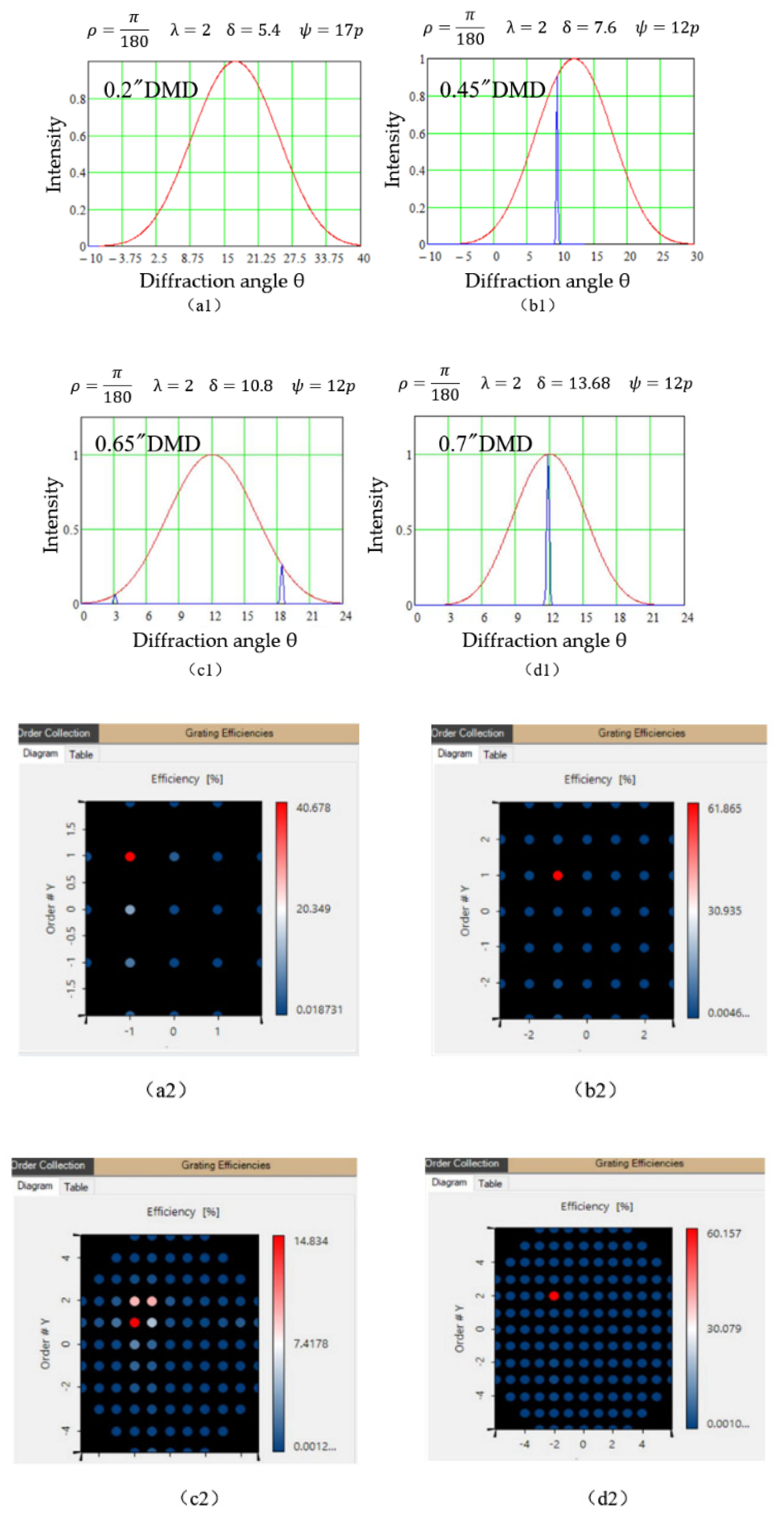

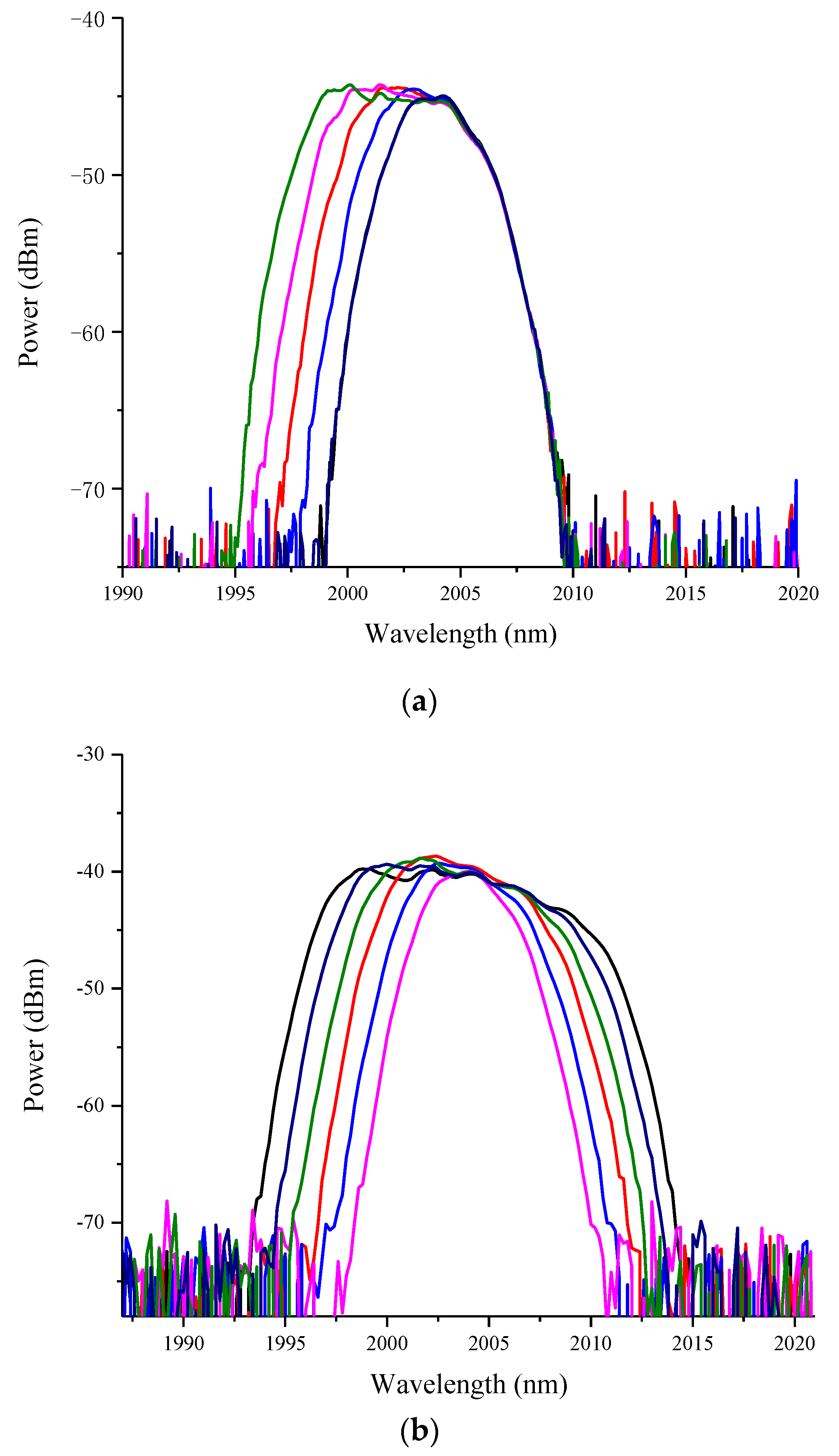
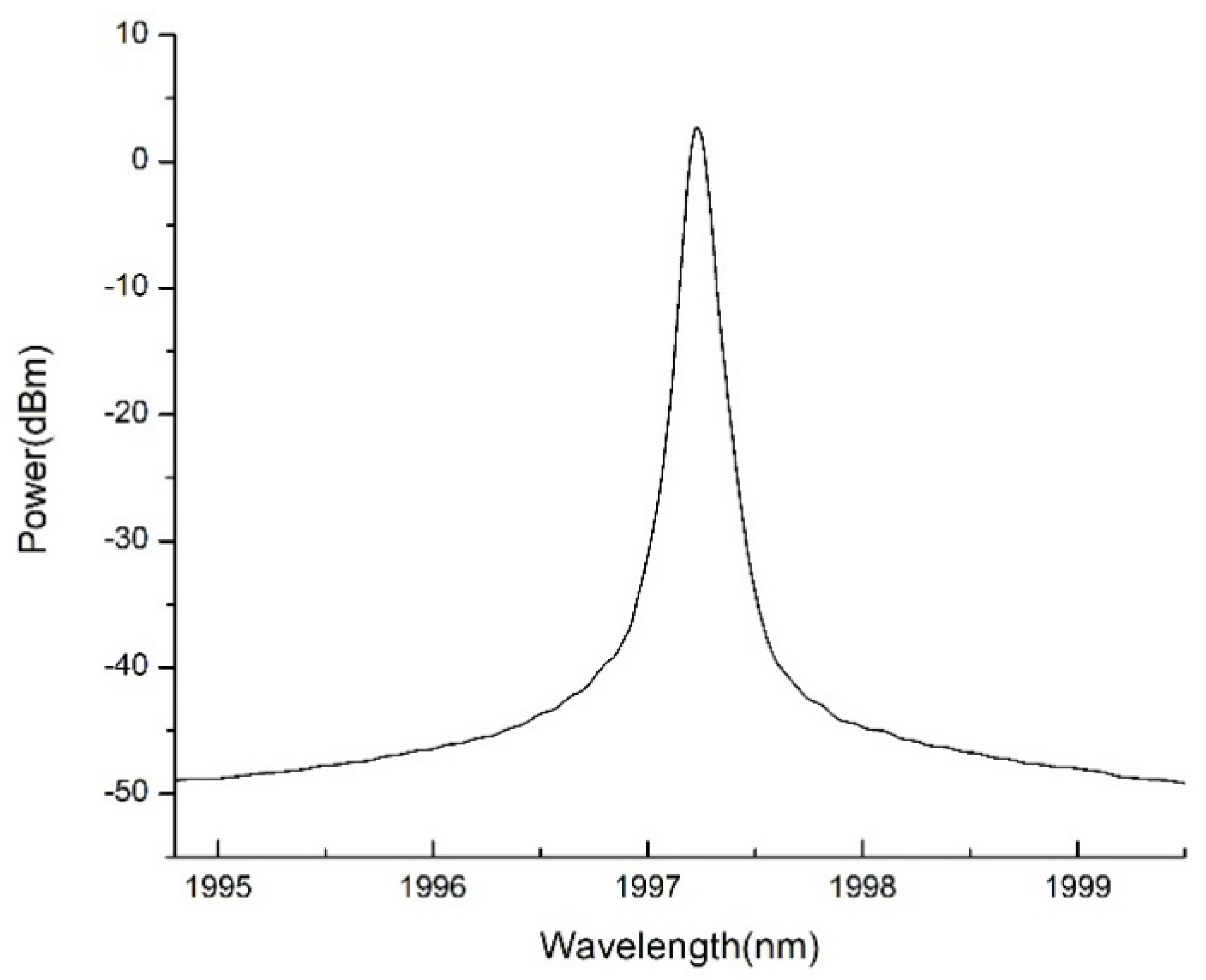
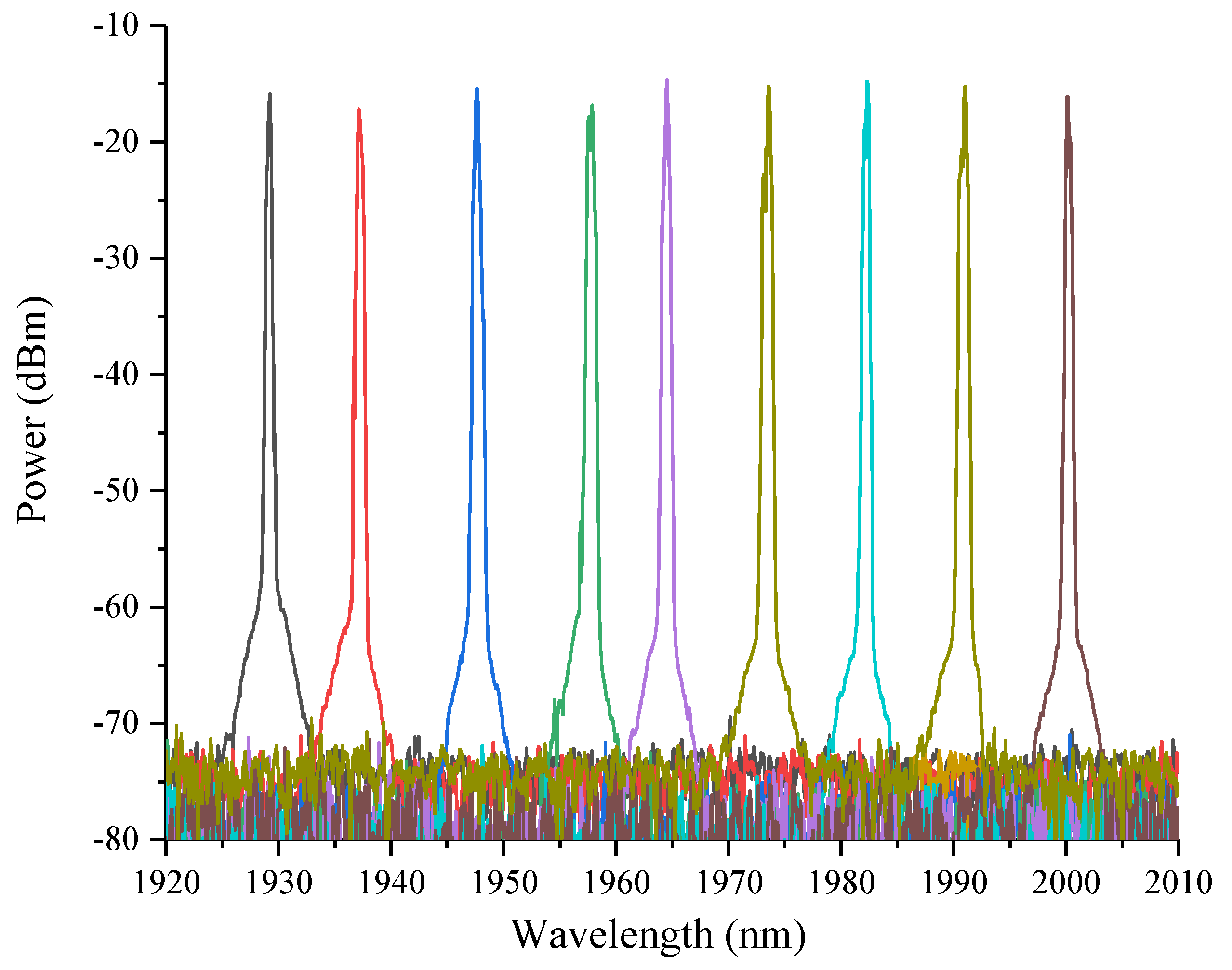
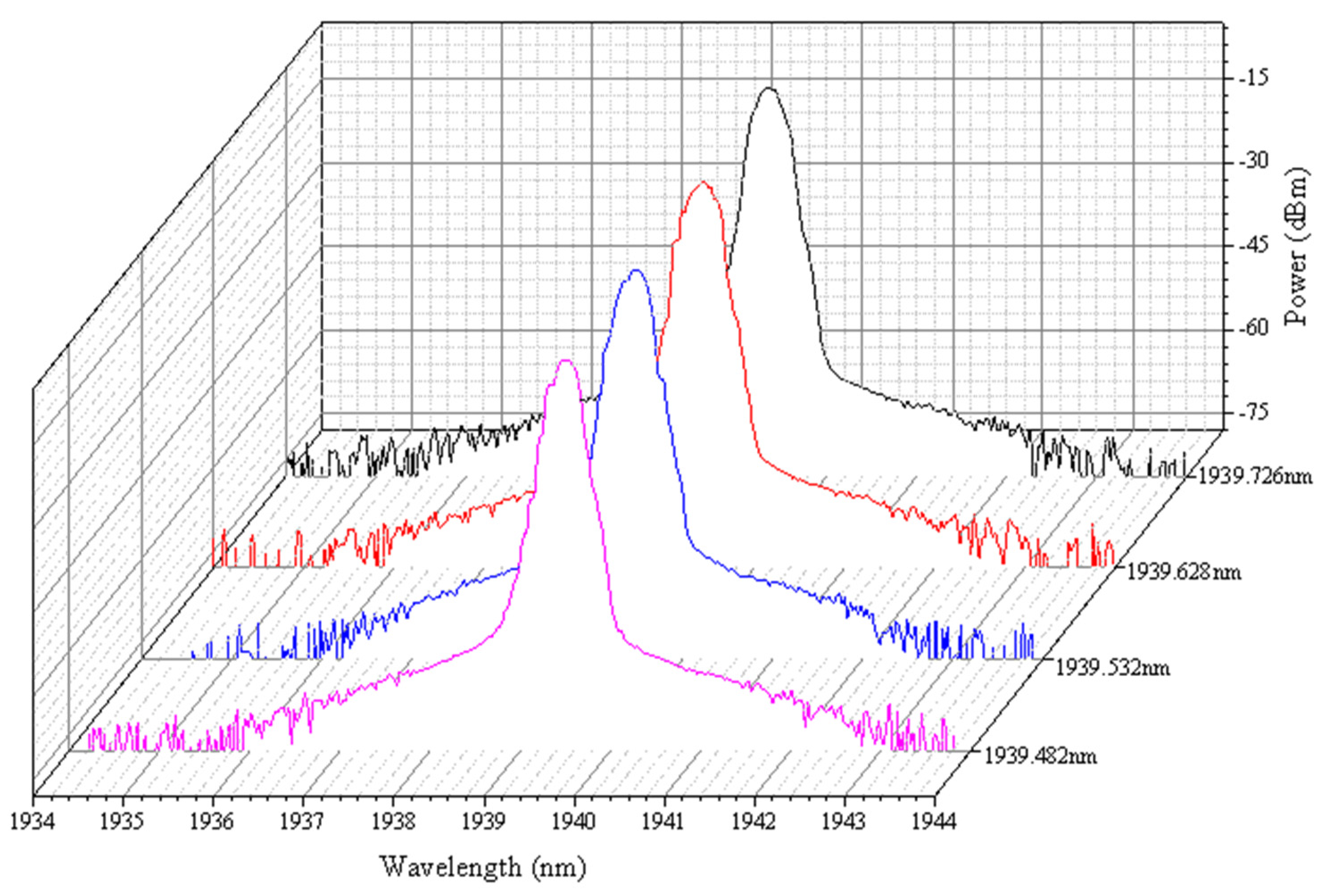
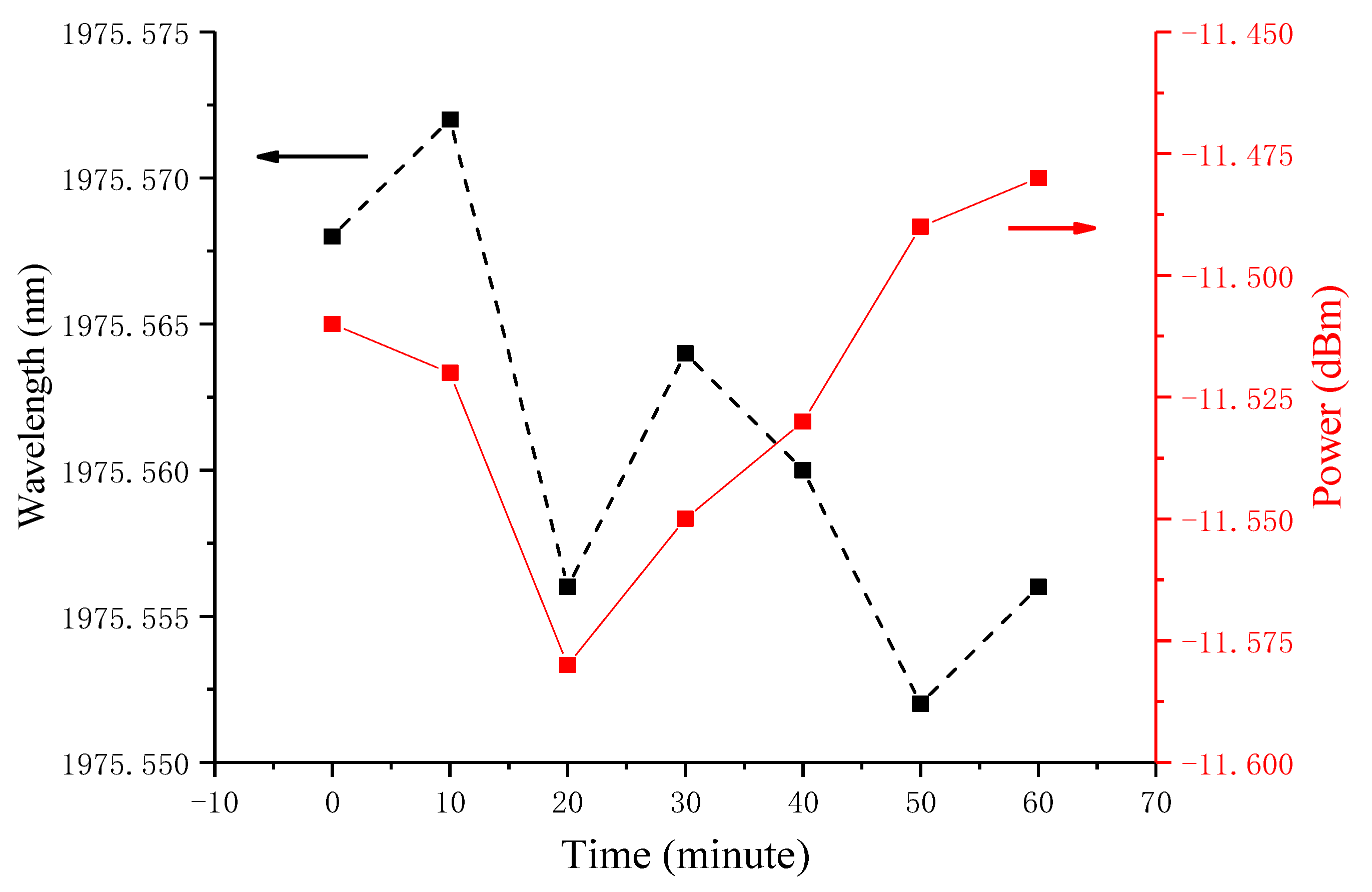
| Type | DLP2010 | DLP4500 | DLP650L | DLP7000 |
|---|---|---|---|---|
| Chip size | 0.2” | 0.45” | 0.65” | 0.7” |
| Micromirror array size | 854 × 480 | 912 × 1140 | 1280 × 800 | 1024 × 768 |
| Micromirror pitch | 5.4 μm | 7.6 μm | 10.8 μm | 13.68 μm |
| Micromirror tilt angle | ±17° | ±12° | ±12° | ±12° |
| Component | Total Loss (dB) |
|---|---|
| Circulator | 1.8 |
| Collimator | 1.1 |
| Diffraction grating | 3.6 |
| Lens | 0.3 |
| Digital Micromirror Device | 3.8 |
| Total loss | 10.6 |
Publisher’s Note: MDPI stays neutral with regard to jurisdictional claims in published maps and institutional affiliations. |
© 2020 by the authors. Licensee MDPI, Basel, Switzerland. This article is an open access article distributed under the terms and conditions of the Creative Commons Attribution (CC BY) license (http://creativecommons.org/licenses/by/4.0/).
Share and Cite
Chen, X.; Dai, D.; Zhang, Y.; Wu, H.; Gao, Y.; Chen, G.; Wang, Y. Wavelength-Flexible Thulium-Doped Fiber Laser Based on Digital Micromirror Array. Micromachines 2020, 11, 1036. https://doi.org/10.3390/mi11121036
Chen X, Dai D, Zhang Y, Wu H, Gao Y, Chen G, Wang Y. Wavelength-Flexible Thulium-Doped Fiber Laser Based on Digital Micromirror Array. Micromachines. 2020; 11(12):1036. https://doi.org/10.3390/mi11121036
Chicago/Turabian StyleChen, Xiao, Dezheng Dai, Yi Zhang, Hongyuan Wu, Yunshu Gao, Genxiang Chen, and Yiquan Wang. 2020. "Wavelength-Flexible Thulium-Doped Fiber Laser Based on Digital Micromirror Array" Micromachines 11, no. 12: 1036. https://doi.org/10.3390/mi11121036
APA StyleChen, X., Dai, D., Zhang, Y., Wu, H., Gao, Y., Chen, G., & Wang, Y. (2020). Wavelength-Flexible Thulium-Doped Fiber Laser Based on Digital Micromirror Array. Micromachines, 11(12), 1036. https://doi.org/10.3390/mi11121036





